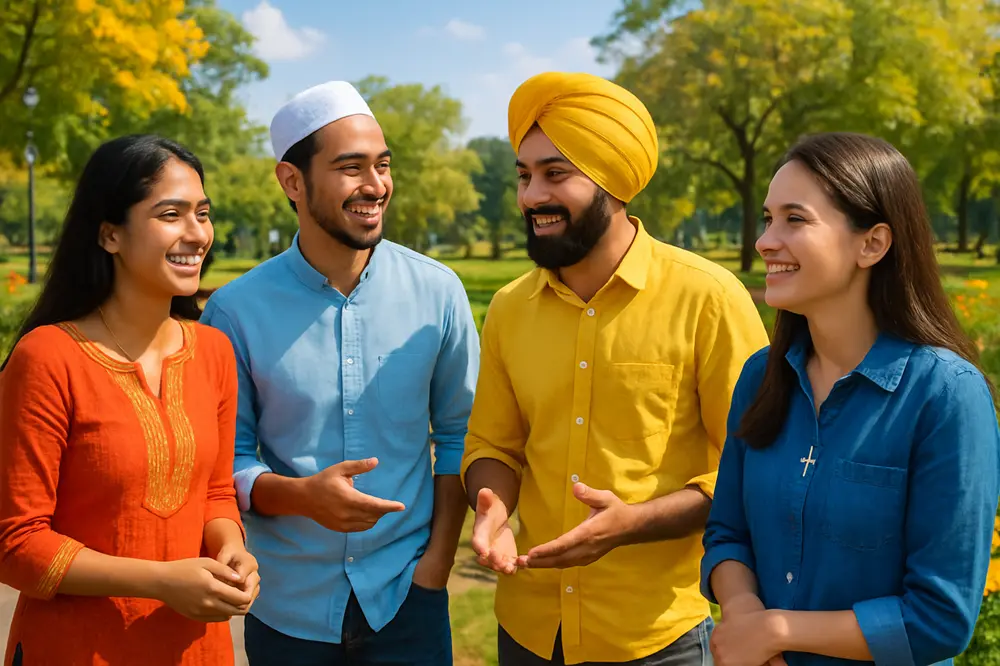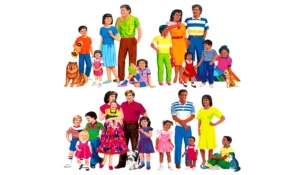Religious polarization in India is profoundly affecting the nation’s youth, shaping their views, social environments, and personal prospects.
The rise in communal tensions, political exploitation of faith, and the echo-chamber effect of social media are creating new divisions among young Indians, influencing their everyday experiences and worldview.
Let’s explore how religious polarization shapes the identity, aspirations, and social cohesion of Indian youth. Understand its psychological, economic, and cultural impacts, and discover strategies to foster inclusivity, unity, and resilience in a diverse society.

The Effects of Religious Polarization on Youth Identity and Social Cohesion in India
Religious polarization is reshaping the world of Indian youth in ways few could have imagined just a decade ago. It’s not just debates on TV or conflict in the news—it’s social media feeds flooded with divisive memes, real-life friendships tested by communal rumors, and families worried about their children’s outlook and safety.
As the digital generation, young Indians face the double burden of online misinformation and echo chambers that push them toward more extreme opinions and mistrust.
The pressures of belonging, anxiety over identity, and exposure to radical views are making it tougher for youth to connect, collaborate, and dream beyond barriers.
Understanding these effects isn’t just about numbers—it’s about the daily realities shaping India’s hopes for the future.
Discover how religious polarization influences youth identity and social cohesion in India. Examine its psychological, cultural, and community impacts, and explore ways to promote inclusivity, resilience, and unity among the next generation in a diverse, multi‑faith society.
What Is Religious Polarization?
Religious polarization refers to growing divides and hostilities based on faith, often fueled by political or social factors. In India, these divisions have grown more pronounced in recent years, making the country’s youth especially vulnerable to antagonism, exclusion, and misinformation.
Real-Life Manifestations
Young people routinely witness communal clashes, hate speech, and discriminatory practices in both physical and digital environments. For example:
- Violent incidents during religious processions or festivals have created cycles of anger and fear.
- Social media platforms are flooded with divisive content, amplifying stereotypes about communities with viral misinformation.
- Educational materials are sometimes manipulated to support particular religious narratives, marginalizing others and distorting history.
Causes of Polarization
Several factors drive religious polarization among youth:
- Political parties exploit religious identities for electoral gains, encouraging divisiveness.
- Biased reporting and propaganda spread through traditional and digital media worsen interfaith misunderstandings.
- Laws like the Citizenship Amendment Act and changes governing minority property rights have heightened fears among minority youths.
- Unemployment and disaffection among youth create fertile ground for radicalization.
Psychological Impact on Youth
Religious polarization leads to increased stress, anxiety, and identity confusion among young Indians:
- Many feel pressured to conform to group norms or political ideologies, fearing ostracism or backlash.
- Growing up in a climate of suspicion makes it harder for youth to build trustful interfaith relationships.
- Some young people become radicalized by echo chambers online that present hostile views towards other communities.
Social Fragmentation
Social segregation caused by communalism results in:
- Young people belonging to different religious backgrounds often living in isolated enclaves, with little opportunity for constructive interaction.
- Limited contact fosters ongoing mistrust and stereotypes, undermining friendship and cooperation.
- Events like communal riots disrupt schools and colleges, threatening educational continuity and prospects.
Economic Consequences
Religious polarization impacts the youth’s economic opportunities in several ways:
- Communal violence and tension deter investments, hurting job growth and innovation.
- Economic instability from riots and property damage restricts mobility and resources, especially for minorities.
- Unequal access to public goods, like education and health care, is common in deeply polarized regions.
Political Radicalization
Polarization encourages youth to adopt rigid, exclusionary political views:
- Young people, especially first-time voters, are targeted by campaign messages emphasizing faith-based loyalties, not national or public interests.
- This undermines secularism and erodes trust in democratic institutions.
- Disinformation campaigns online manipulate youth opinion and mobilize them for divisive political agendas.
Impact on National Unity
Communal polarization undermines the sense of national identity:
- Loyalty to religious identity often trumps national identity in deeply polarized settings.
- Efforts to promote inclusive values and patriotism meet resistance in environments marked by suspicion and hostility.
- Youth movements for solidarity or rights are sometimes derailed by internal religious tensions.
Effects on Minority Youth
Muslim and Christian youth in India face:
- Systematic marginalization and exclusion from educational and employment opportunities.
- Discrimination via social policy, like the CAA and NRC, engenders uncertainty about citizenship, rights, and future prospects.
- Daily experiences of bias—such as being denied medical care or public services in times of crisis—lead to alienation and a sense of insecurity.
The Role of Social Media
Digital platforms play a central role in shaping young people’s beliefs:
- Algorithms create echo chambers, reinforcing divisive and extremist narratives.
- Viral misinformation reaches youth rapidly, shaping perceptions even before facts emerge.
- While some initiatives exist for fact-checking and community reporting, they are often insufficient, underused, or not sensitive to local contexts.
Read Here: What is the Impact of Social Media Algorithms on Polarization?
Which social media trends most fuel religious polarization among Indian youth?
Social media trends fueling religious polarization among Indian youth include viral misinformation, identity-based echo chambers, and communal hashtag activism.
Platforms amplify sensational and divisive content through algorithms that prioritize engagement over accuracy, exposing youth to biased narratives and conspiracy theories.
Influencer-driven communal rhetoric and meme wars stoke interfaith animosity, often intensifying existing prejudices. Hashtags linked to religious controversies mobilize youth politically but also deepen divides.
Polarized comment sections and group chats create online spaces where intolerance thrives, making it hard for youth to encounter balanced perspectives or engage in constructive dialogue.
What role does education play in building resilience against religious divides?
Education fosters resilience against religious divides by promoting critical thinking, empathy, and respect for diversity. It equips youth with historical and cultural awareness, helping them challenge stereotypes and resist divisive narratives.
Inclusive curricula encourage dialogue, shared values, and cooperation across faiths. By nurturing civic responsibility and ethical reasoning, education builds social cohesion and empowers young people to address conflicts constructively.
Ultimately, it transforms diversity from a source of tension into a foundation for unity, mutual respect, and long‑term societal harmony.
Educational Disruptions
Religious polarization interrupts the learning and growth of youth:
- School and university environments become battlegrounds for ideological clashes, at times disrupting classes and exams.
- Curriculum modifications sometimes promote narrow religious viewpoints and underrepresent India’s diverse heritage.
Impact on Gender Relations
Polarization can worsen gender-based discrimination:
- Young women from minority communities may face additional barriers to education and mobility due to religious tensions.
- Both boys and girls encounter pressure to conform to rigid social norms dictated by their community in polarized climates.
Long-Term Consequences
If unchecked, religious polarization carries substantial risks for India’s youth:
- The erosion of pluralism and secular values consolidates group identities at the expense of national unity, setting the stage for future conflicts.
- Economic stagnation, high unemployment, and persistent social distrust lock generations in cycles of poverty and resentment.
- Weak institutional trust and chronic instability deter investment in youth development programs, from entrepreneurship to sports.
Coping and Resilience Strategies
Indian youth cope with religious polarization through resilience, dialogue, and unity‑building strategies. Learn about psychological, social, and cultural tools that empower the next generation in a diverse society.
How are Indian youth responding?
- Some join interfaith groups, participate in peace-building workshops, or engage in community-driven civic initiatives to build bridges.
- Digital literacy and critical thinking programs in schools aim to prepare youth to navigate disinformation.
- Movements advocating for diversity, equality, and secularism are gaining momentum among youth groups and student unions.
Practical Recommendations
To address and reduce religious polarization among youth, experts and activists recommend:
- Promoting inclusive education that respects India’s plural heritage and teaches critical thinking.
- Ensuring fair access to jobs, healthcare, and public goods for all religious communities to eliminate economic disparities.
- Supporting media literacy programs to help youth consciously recognize and reject harmful online narratives.
- Encouraging young people to engage in dialogue and community service across faith lines to foster trust and cooperation.
Read Also: How Does Religious Intolerance Impact Social Harmony in India?
Conclusion
The effects of religious polarization on Indian youth are multifaceted and far-reaching, touching every aspect of their lives—from psychological well-being and educational achievement to social relationships and future prospects.
Addressing these challenges will require persistent effort from families, communities, schools, and policymakers.
Only through inclusive dialogue, fair opportunities, and sustained advocacy can India’s diverse youth realize the pluralistic ideals on which the nation was founded.





